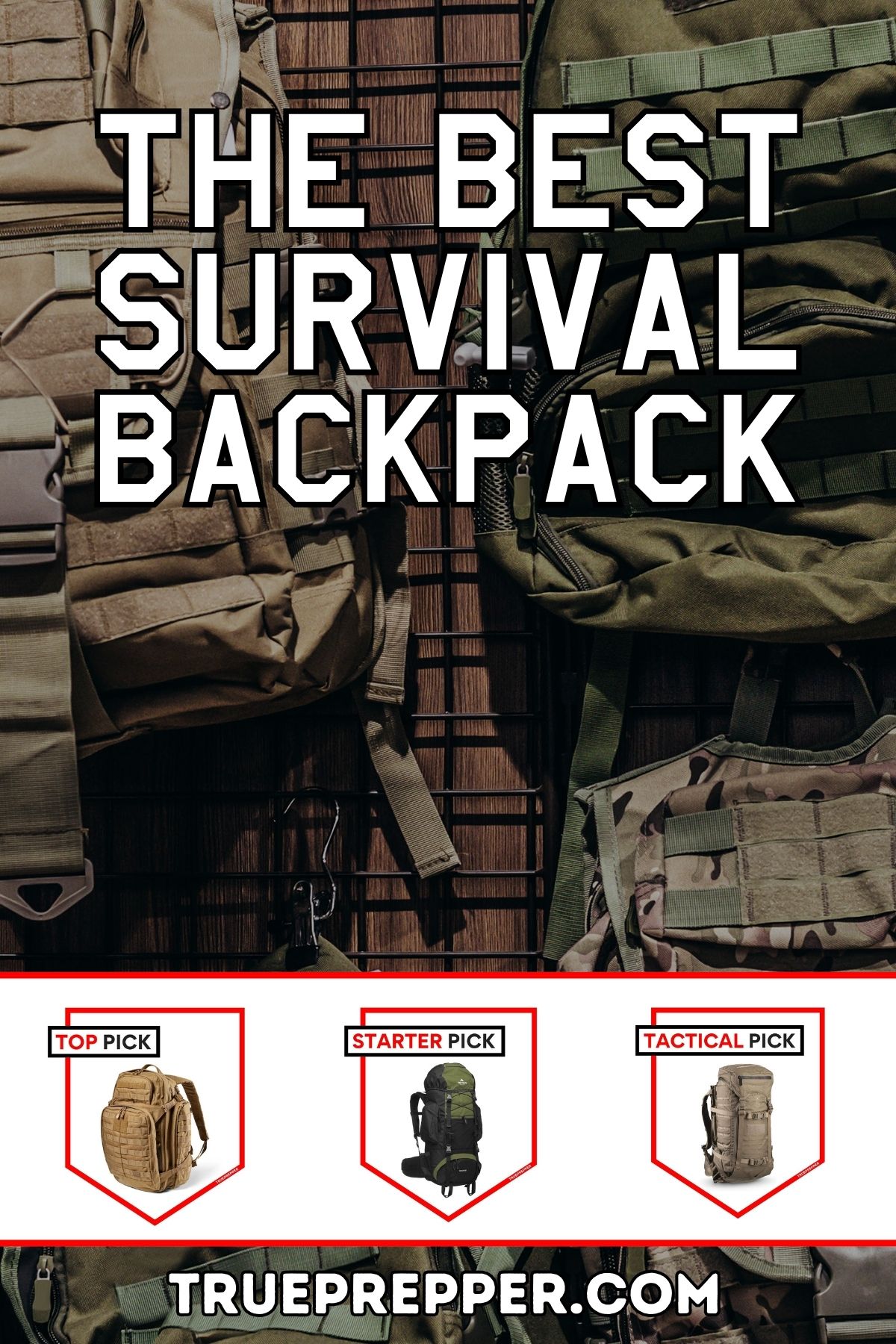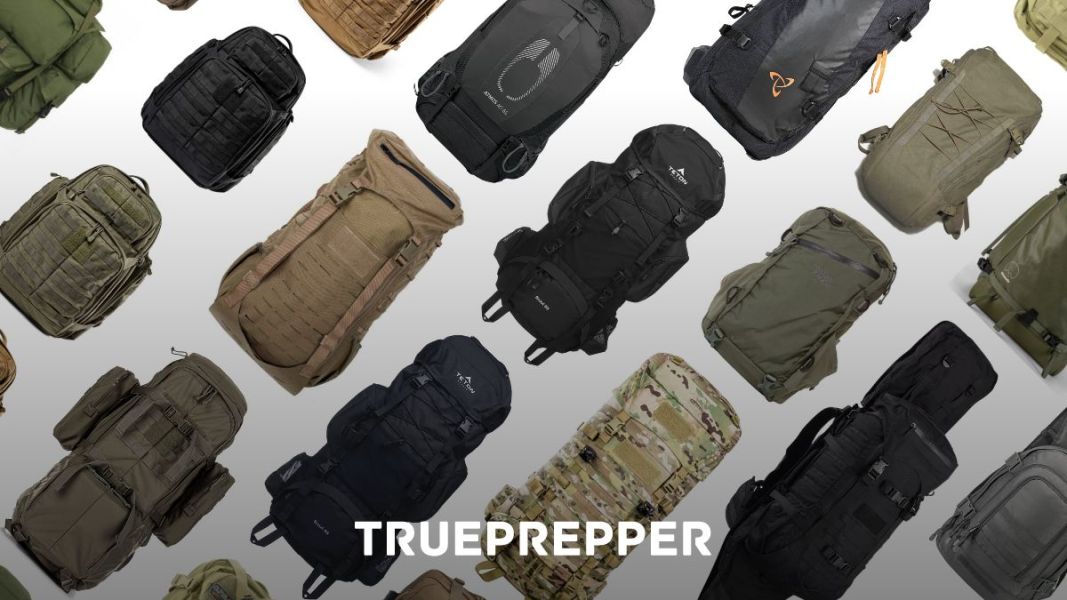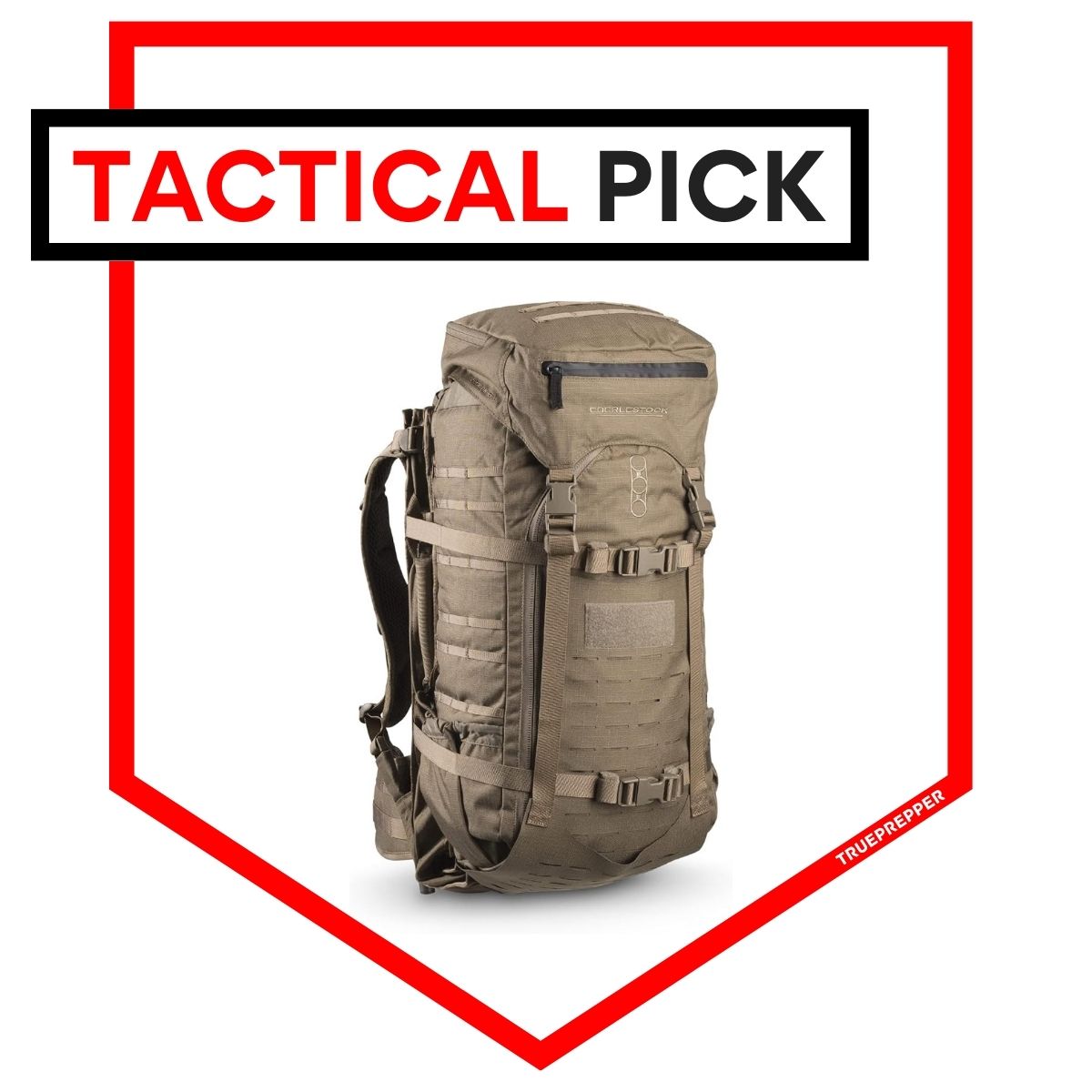Best Survival Backpack | Hands-On Tested
This is an updated review of the best survival backpack. Our first review was seven years ago and we will continue to update as new products are released and as we test even more tactical, hiking, and travel bags.
A good survival backpack will hold your gear and get you to where you need to go when things go south. A great backpack will get you there easier, smarter, and for less money. The best survival backpack will organize all the gear you need, be comfortable carrying large weights, and be the most durable on the market. There are plenty of backpack types and brands to consider for bugging out.
That’s where we come in. We’ve researched and reviewed the top bags, put them through the paces, and literally ripped them apart at the seams. The results are in: the overall best, a budget option, and a tactical option. If you need a backpack to keep up with you when you need it most, one of our suggestions is up to the task.
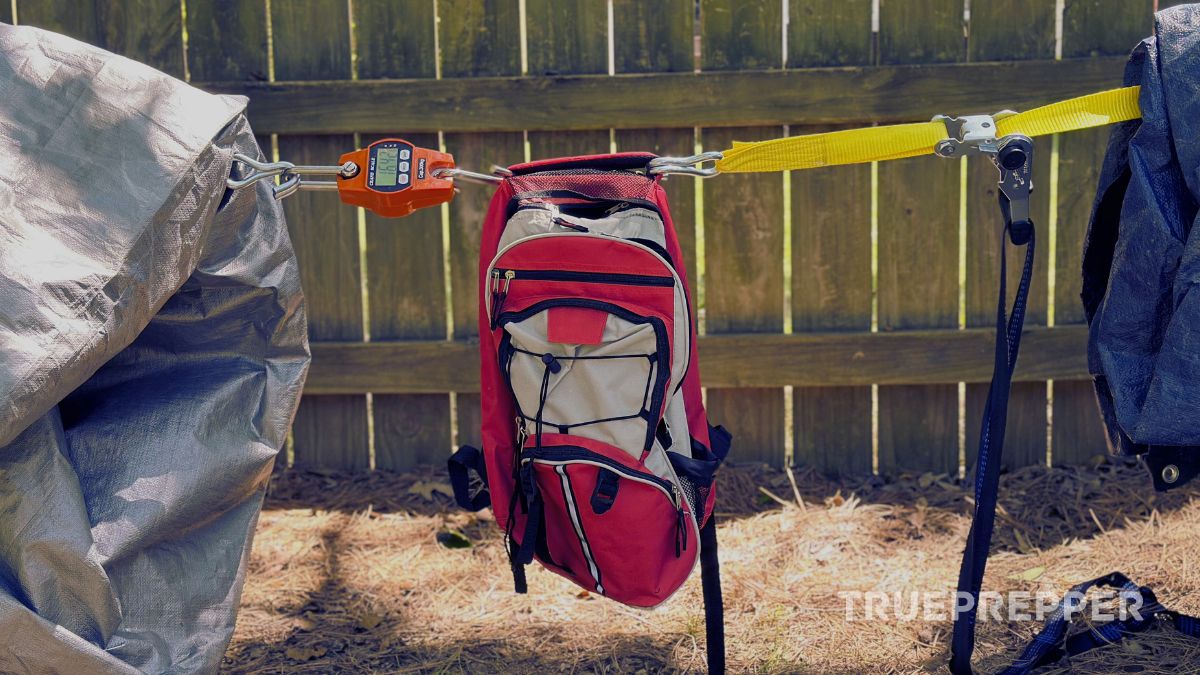
Contents (Jump to a Section)
The Survival Backpack
Rush 72 2.0
Expandable, Customizable, and Durable
The second iteration of the Rush 72 builds on the strengths of the previous best survival backpack.
*Price at time of publishing; check for price changes or sales.
This is the quintessential survival bag, and it comes in a variety of sizes from the Rush 12 all the way up to the Rush 100. The 72 model hits the sweet spot with 55L of space, meaning it is designed to be a 72-hour bag (ideal for bug outs).
Your SHTF situation would not be a 5.11 Rush bag’s first rodeo. It is a solid choice and is consistently trusted by both law enforcement and military operators.
Here are the quick hits:
- 3340 cubic inches (55L) – more sizes available though
- 1050D Nylon
- Adjustable sternum and yoke straps
- 16 compartments and MOLLE
- CCW, hydration, and laptop (15″) pockets
- 5.3 pounds
My favorite features of this bag are the hefty 1050D Nylon fabric paired with the many ways to configure this bag for your specific kit. The bag is simple but has countless attachment points for expansion. I like to create modular-type kits so the many compartments work well with my exact loadouts.
These bags have a reputation for being as tough as a nickel steak and can take some abuse, and we can confirm that the 5.11 Rush 72 2.0 Backpack is the most solid survival backpack option.
Budget Survival Backpack
Scout 55
Large capacity, Comfortable, and Lightweight
This proven backpack is perfect for bugging out with plenty of room for gear while still being comfortable long distances.
*Price at time of publishing; check for price changes or sales.
Backpacking is a sport that is basically people bugging out over long distances for fun. The few differences are that maybe you aren’t avoiding other people and you may have a few more resources along the way, but these bags are designed for long-distance travel. They keep the bags light with heavy-duty but lightweight fabric. They keep them pretty clean of straps and decorations to keep the weight down as well. Backpacking backpacks are optimal for mid to long-range bug out travel.
Here are the specs:
- 3400 cubic inches (55L) – more sizes available though (45L – 65L)
- 600D Polyester
- Dual aluminum 3/4 frame
- Sleeping bag pocket, integrated rain fly
- 4.5 pounds
Some of my favorite parts of this bag are the internal frame attached to the adjustable lumbar and the construction quality of the critical parts of the bag. Sure, eventually the elastic straps and water bottle holders will wear through or separate from the seam- but the shoulder straps and main compartment are well engineered with double stitched and folded main compartment seams and smartly-placed ‘box and x’ stitches for distributing strap loads.
This is one of the cheapest bags you’ll find us suggesting due to durability, but this one will still keep up. If your BOL is a good distance from your home, the Teton Scout 55L Internal Frame Backpack makes a solid survival bag choice.
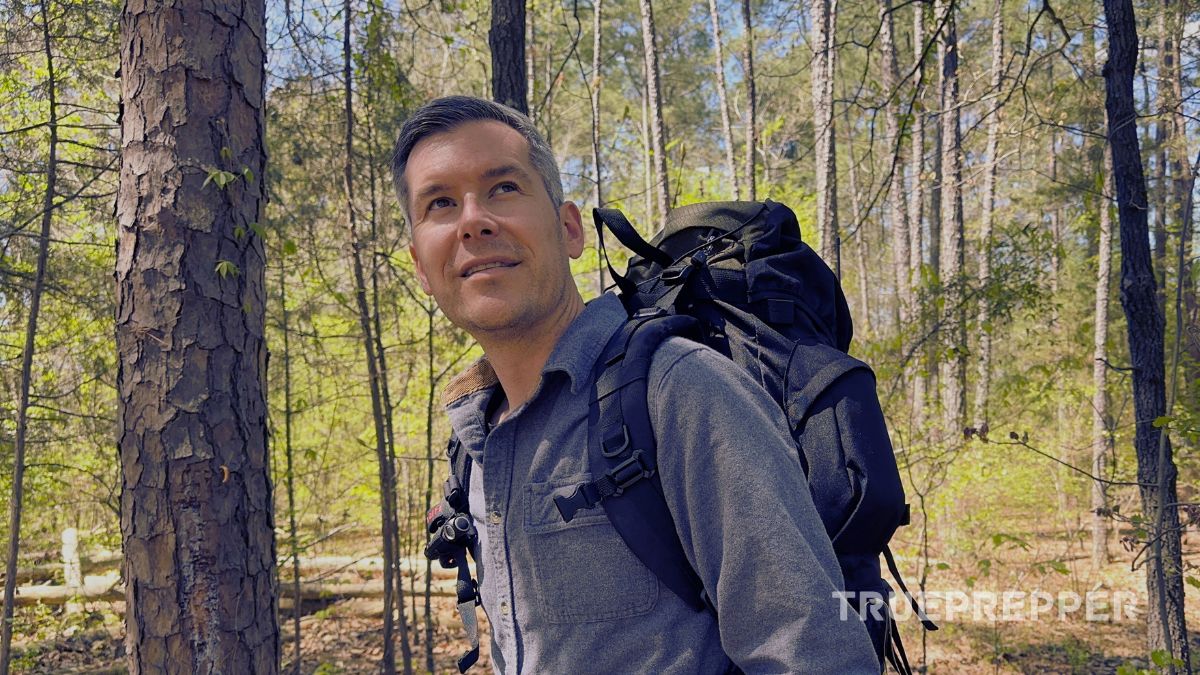
Tactical Bug Out Bag
Gunslinger II
Well Designed, Versatile, with Top-Tier Construction
This assault pack is designed ground-up for bugging out and pulls it off with unmatched toughness and versatility.
*Price at time of publishing; check for price changes or sales.
The Gunslinger II is one of Eberlestocks’ most expensive bags from their Mission line. It is extremely well-designed using the best materials you can find. The G2 costs a pretty penny but will reward you with a lifetime of service. It brings extreme versatility, with plenty of organization designed around the internal frame.
Here are the specifics on how it measures up:
- 2700 cubic inches (44L) including scabbard
- 1000D Nylon (Cordura polyurethane-coated)
- Intex II tubular frame
- MOLLE, PALS, Alice compatible
- Rifle scabbard (600 ci) for weapons up to 60″
- 6.5 pounds
This bag is a beast and takes the best parts of the rest of the Mission lineup. It has a scabbard to keep a long rifle (and optics) covered completely. The best part of these bags is the craftsmanship. There is attention to detail on the internal seams that other bags don’t even address in their main compartment.
My second favorite part of the G2 is how configurable it is. Even if you aren’t a gunslinger yourself, you’ll find plenty of uses for this bag and the integrated scabbard. The downside, of course, is that the bag costs over $400 and is usually excluded from sales. To justify this purchase, you’ll need to plan to use it and consider it an investment.
When it comes to survival, you’ll want the top-tier Eberlestock Gunslinger II Backpack on your six.
Everything We Recommend
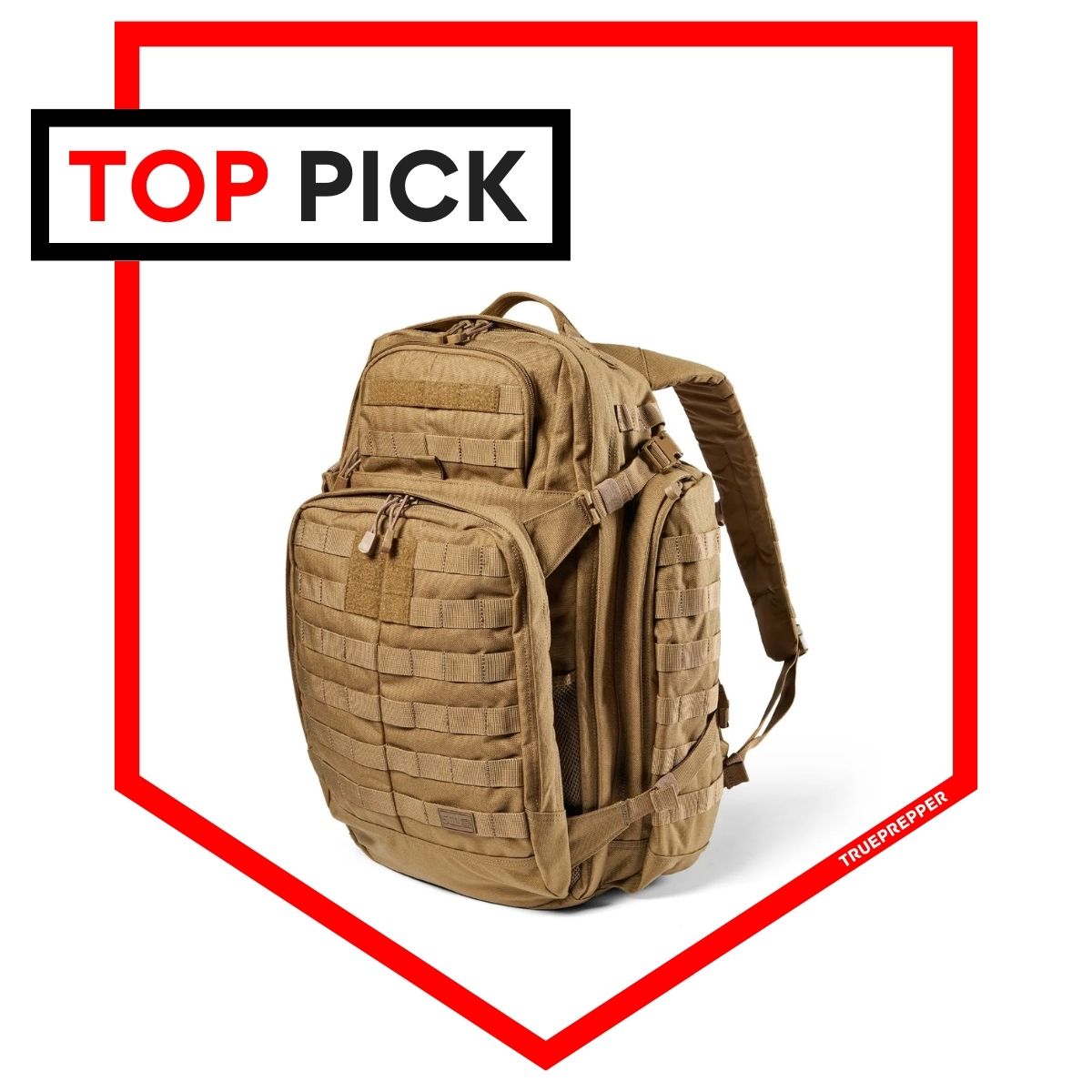
The second iteration of the Rush 72 builds on the strengths of the previous best survival backpack.
Where to Buy
*at time of reviewing
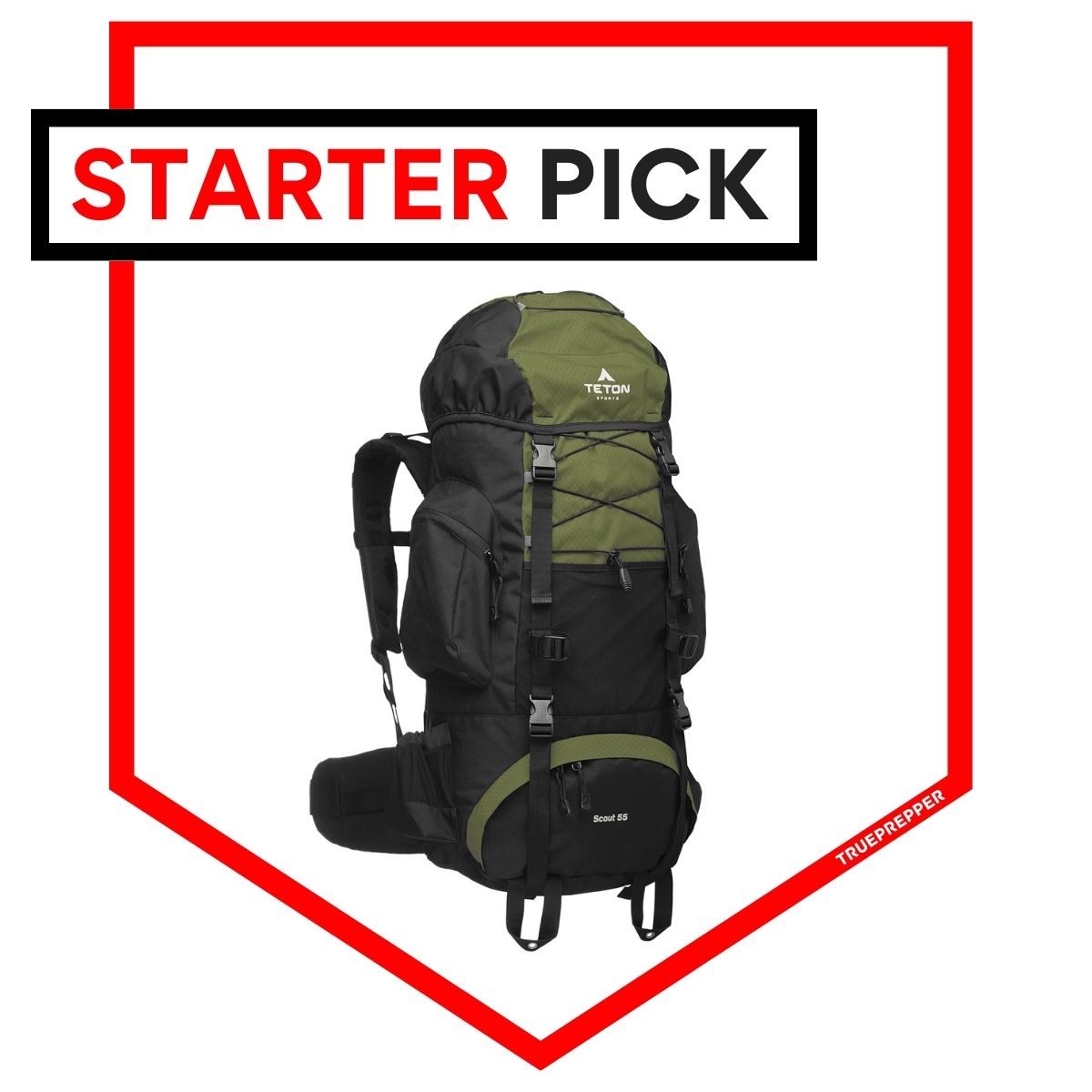
This proven backpack is perfect for bugging out with plenty of room for gear while still being comfortable long distances.
Where to Buy
*at time of reviewing
The Backpacks We Compared
Our research narrowed the field down to the several backpack brands and types that we tested: 3V, 5.11, Kelty, Vertx, Eberlestock, High Sierra, Blackhawk, Maxpedition, Mystery Ranch, Mardingtop, and more.
You can see our full list of review criteria below in the What to Look For section, with an explanation for each.
We did not consider smaller bags, sling bags, or pouches even though those can be viable.
We’re always looking for new and better equipment, so if you have a backpack that you swear by let us know down in the comments. We review most of our tested gear annually, so we can always get it in the next roundup round and see if it makes the cut and we can see if it will beat out our top picks.
What to Look For
The best survival backpacks have several important features to look for:
- Value
- Functionality
- Durability
- Size & Weight
- Versatility
When you get the right blend of these, you can find a truly reliable backpack that will let you carry all of your essential gear. Below, we break down what each of these features means for a dependable pack that you can trust with your life:
Value: Cost vs. Benefit
The amount of money you spend on something like a backpack shouldn’t blow out your entire budget. Don’t go overspending or overdoing it. Budget according to your risk and your needs rather than just spending lavishly.
On the flip side, you don’t want to go too cheap or just plain get the wrong thing. There are plenty of cheap backpacks out there, or backpacks made for a different purpose that won’t work as well.
You never want to spend too much money on one resource, especially something like a backpack. It’s better to diversify your tools and preparedness gear to make sure you are covered for a wide range of scenarios. There is a sweet spot where you get high value out of the best features with not too high of a price, which is where our top pick sits.
Functionality
Functionally, any bag that will fit your gear could technically be a survival bag. But considerations should go far beyond that. You want it to hold your gear well, in an organized manner, and for it all to be comfortable on your back- which is scientifically verified to be the best place to carry it (in most situations).
Of course, there are other options: roller bags (think of the airport), Pelican cases, and even the old bandana-tied-to-a-stick are all options for your survival bag. Many of the bags/cases/boxes without shoulder straps are being used by plans that rule out bugging out by foot.
Prepping for these situations can be tough when considering congested highways, EMP effects, and scarce power resources. But some have it figured out to the best of their ability and will not need to hoof it across the countryside to their bug out locations.
Some preppers with extensive planning will use caches along their bug out route to minimize the gear and supplies they have to carry with them. If you find your bug out plans becoming long and convoluted, remember that keeping a plan simple is sometimes the best course.
Durability
Backpack design, material quality, and construction quality determine a bag’s durability. Cheap bags can fake the look just with design. Adding straps and do-dads to the outside can make a bag look tactical, even if it can’t perform. Quality brands typically have good design, similar material quality (many of them use the same vendors), and excellent craftmanship.
Material Quality
Heavier weight textiles, thicker and wider straps, metal zippers, waterproof zippers: all of these significantly improve durability (at a cost). For survival purposes, we believe these are all worth it. You don’t want straps breaking on you when you are navigating the tough times survival situations present you with.
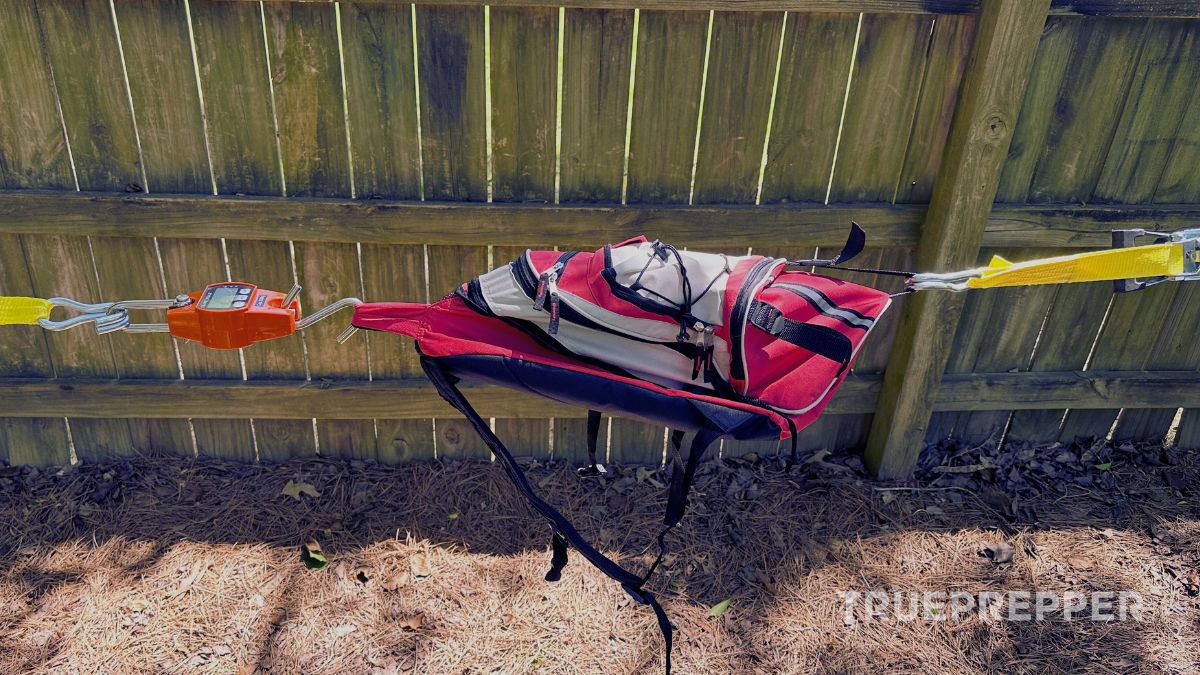
Design can sometimes make up for lighter and less expensive materials, but generally when it comes to straps: the bigger the better. Some backpacks use suspension rigs, triangle force distribution, or proven stitching techniques to reduce the chance of a strap fraying or buckle breaking.
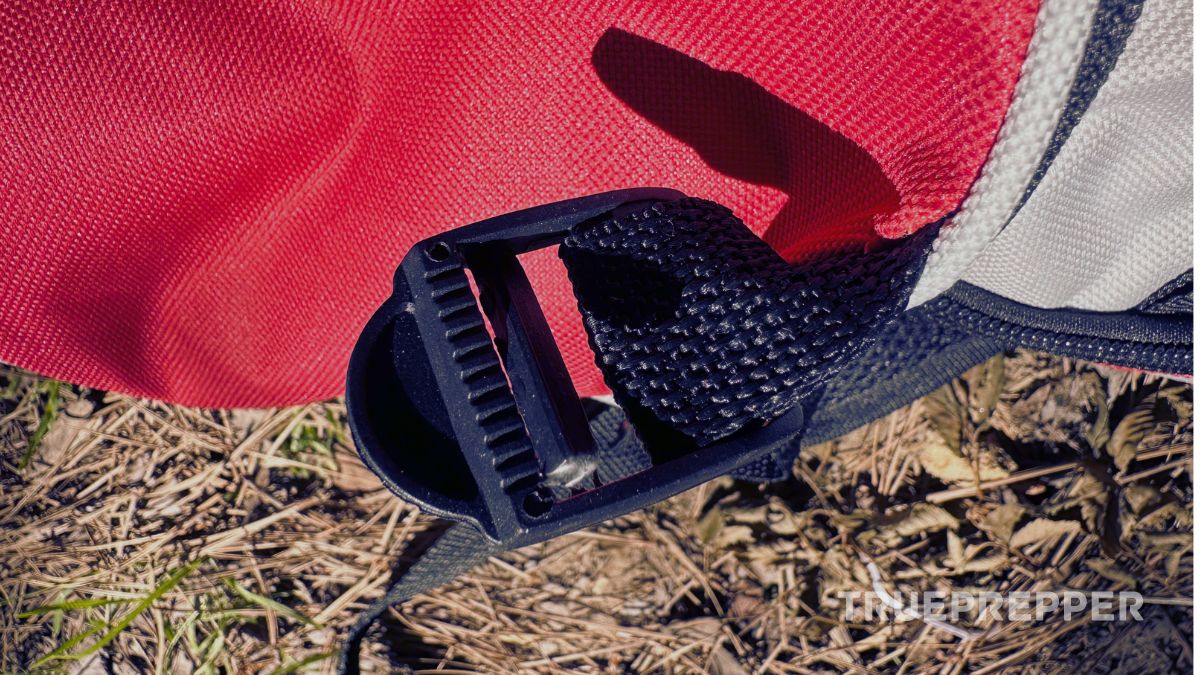
Lightweight but strong textiles and straps are key for survival bags, especially those designed to be used indefinitely. Most bags use synthetic fabric like nylon or polyester with different weights and weaves.
While polyester is the main pick for backpacking brands’ shell material, heavyweight nylon is the workhorse and is used even more extensively in tactical bags. Some of the quality brands even bump up their nylon from 600D to 1000D+. Specialized needles are used to prevent needle breaks when sewing these heavyweight fabrics.
When designing areas of backpacks where the bag will contact your body, backpacking and EDC bag manufacturers typically use spacer knit material. This is the material that looks like mesh, and it’s meant to reduce contact pressure and improve airflow. The downside to spacer knit is that it is not very durable, and can snag and fray from abrasion.
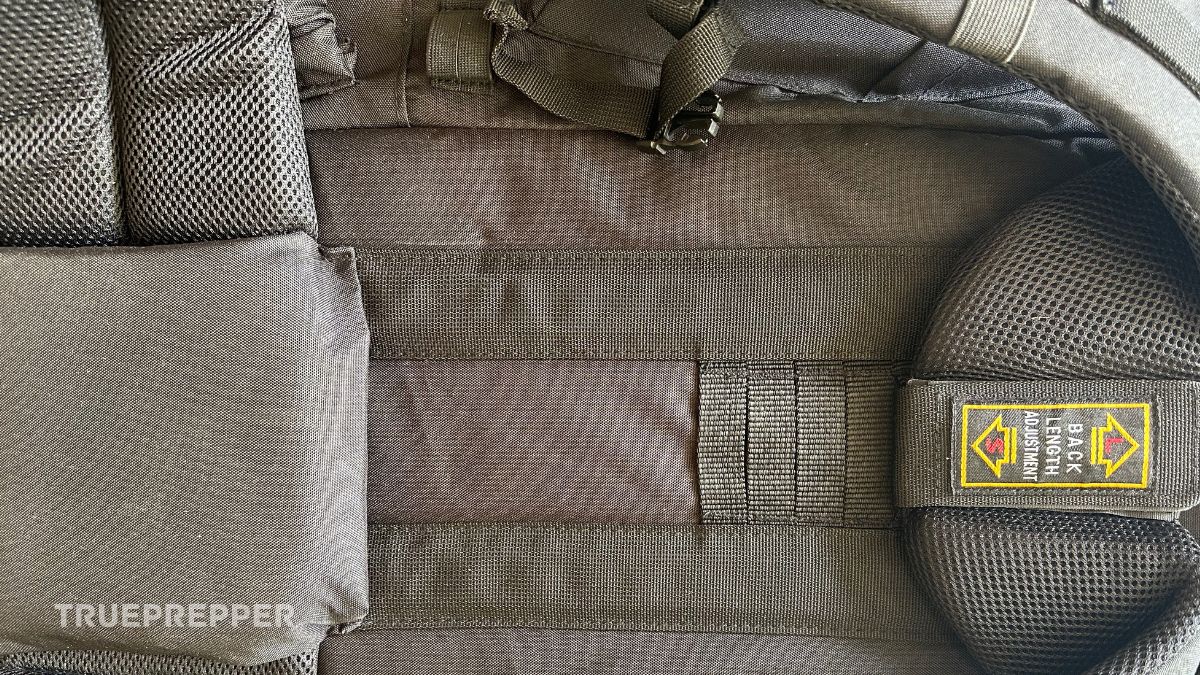
Construction Quality
After material quality comes construction quality. Construction quality is shown mostly through the stitching, although some design features can highlight it as well. A few stitch patterns that indicate good construction include:
- Double stitch – Material seams are stitched twice in parallel, usually less than 1/8″ apart.
- Folded seams – Raw fabric edges shouldn’t be visible on a bag. Fabric is folded while it is sewn to prevent tearing and pulling.
- Bar tack – A dense stitch for attaching straps and fabric at a single point.
- Box and X – A square or rectangular box is stitched with an ‘X’ inside to distribute strap force where it is attached.
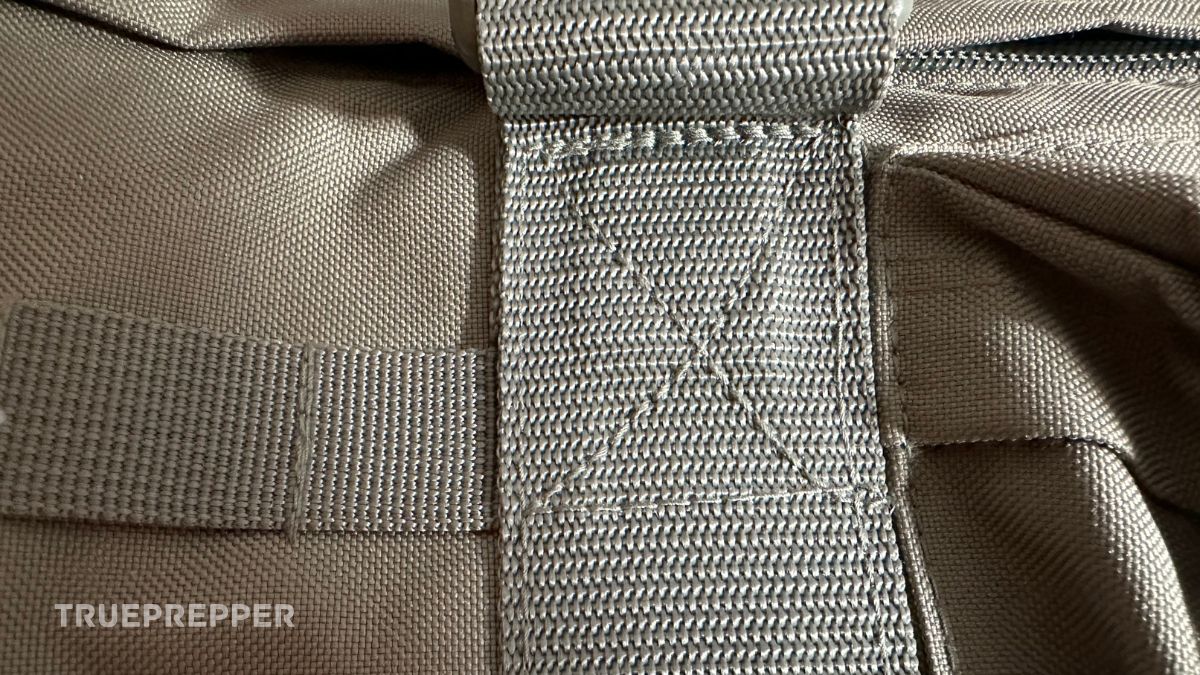
Like I said before though, cheap companies can knock off a look. Besides stitch patterns there are a few other telltale signs of quality:
- Loose stitches – Good bag manufacturers have quality control and toss these out for rework. All sewing machines can have issues with tensioning, but if you can pick a stitch with your nail you’ve got a crappy backpack that could fall apart at the seams.
- Quality combinations – What separates the good from the great is attention to detail. Double stitching is usually reserved for the main compartment of bags, but when you see it on an internal zipper tape seam, you know that the zipper is there to stay.
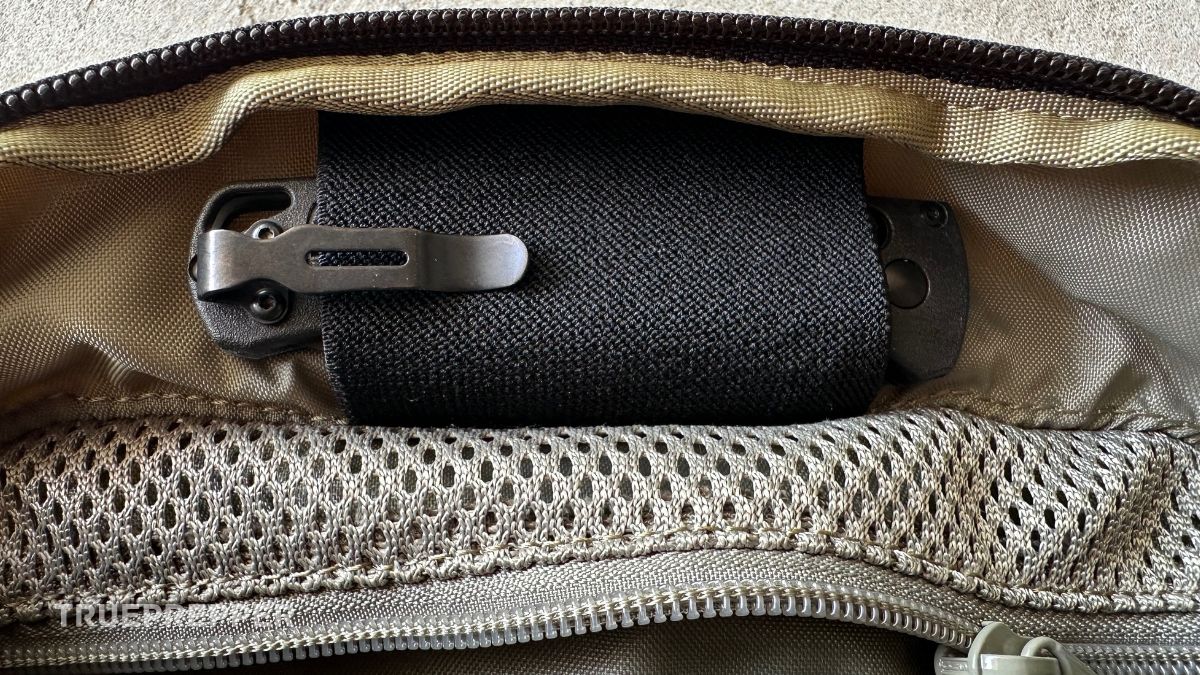
Take care of your backpack as well so it lasts as long as intended. Don’t kick it around unnecessarily, store unsheathed knives in it, etc. Just keep it clean and use common sense.
Size & Weight
The capacity of your backpack can range quite a bit. This also increases the size and weight of the bag. When you are traveling any distance, you will quickly notice that ounces matter.
Here you can see how the backpack capacity compares to the average male’s profile:
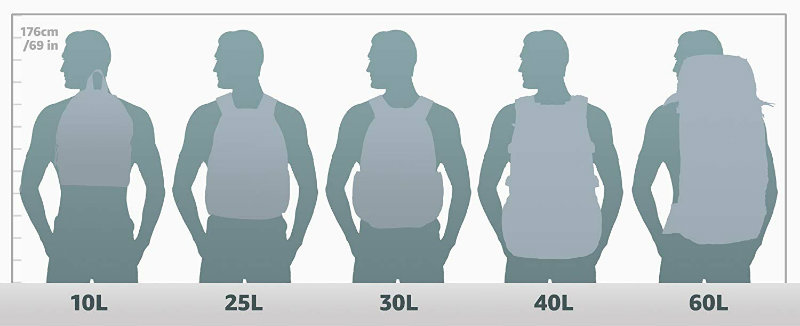
Finding the ‘sweet spot’ between capacity and portability is the key to getting the right bag. This usually depends on what you are using the bag for. Your own size and capability can influence how large of a pack you can handle as well. We’ll talk about weight restrictions with packing further below, but you don’t want the bag itself adding too much unnecessary weight too.
Some examples of kits matched up with appropriate sizes include:
- Everyday Carry – 10L – 30L
- Get Home Bag – 20L – 30L
- Bug Out Bag – 30L – 60L
- INCH Bag – 40L – 75L +
- SCARE Bag – 10L – 20L
You may notice that many of these kits’ ranges overlap with the 30L capacity, which is why this size is so popular. You may be restricted in size, but you will be comfortable without overloading yourself with unnecessary weight.
Versatility
Versatility is where the tactical backpacks really shine. You can add more storage, and compartmentalized kits using MOLLE, ALICE, hook and loop, or tied attachments. They stem from military applications, so they are designed to be versatile for a wide range of equipment and environments.
Avoid elastic components, even if you believe they give your bag versatility. Regardless of the quality, stretch materials eventually give way. If you are looking for a true survival bag with limitless durability, avoiding elastic straps, bungees, and pull cords can help (or just know that they won’t always be reliable).
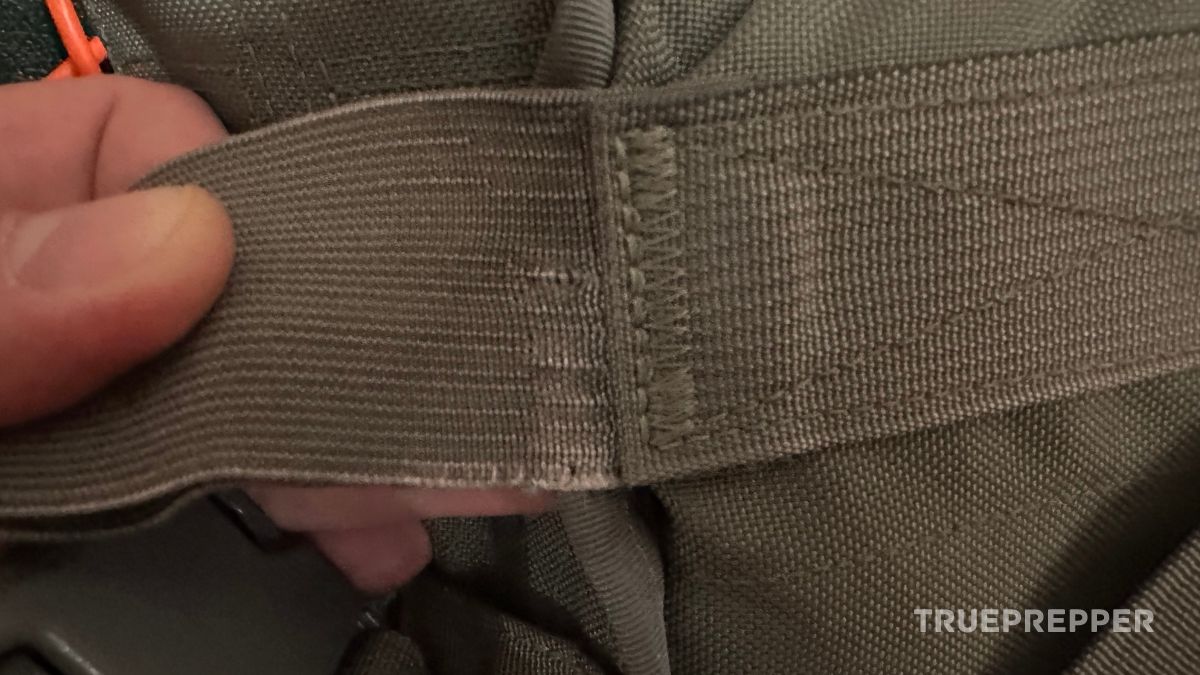
Higher capacity in a bag can give you more versatility as well, just in that you can carry more gear if weight allows it. Rolling wheels and the ability to convert into a duffel make sense in certain situations, especially if you are packing more weight than you ought to carry.
How to Pack a Survival Backpack
Survival backpacks are all about functionality and versatility, and these are the main points to consider when packing the bag as well. The function of the bag is to simply provide you with the resources you need to survive in an expedient, portable solution. To accomplish this, the backpack should be versatile to tackle both known and unknown problems, risks, and situations that will arise.
There are three main priorities to consider when packing your bag:
- Weight Distribution
- Resource Accessibility
- Appearance
Different types of kits will dictate what you should put in these bags, but the principles stay the same throughout all of the options.
Weight Distribution
The most popular method, and a good fallback for any new prepper, is to pack with your bag weight distribution in mind. How much weight you can carry depends on your bag selection, body type, and fitness level. A very vague rule of thumb is that 25% of your body weight should be your bottom line max, yet this measure can overload you for long distances- especially if you weigh more. Pack weight is something that gets much harder to handle with every pound you add.
The difference between 40-41 pounds can have a much different effect on your body than the difference between 20-21 pounds. This is further complicated by how you distribute the weight within and on your pack. A top-heavy pack will require more muscle control stabilization, tiring you out even quicker. The backpacking community is a great resource for learning to properly pack a bag for the best weight distribution.
There are many great videos out there discussing this, and Marco Johnson does a great job here.
Resource Accessibility
With the various situations you could encounter, quick access to your equipment may make the difference between life and death. Tactical packs excel at having equipment within a moment’s reach, but other types of bags may need some packing forethought here. Safety and security equipment are the highest priority equipment to have rapidly accessible, and on your body if possible. Other rapid accessibility considerations include common-use versatile tools.
A multitool, zip ties, and 550 paracord are all extremely versatile resources, but won’t do much good if they are lost in the bottom of your bag. Use external pockets, straps, and tethers wisely to keep important items within reach.
After you concentrate on your rapid access equipment, think about the rest of your supplies and the best logical way to store them. Weight usually takes precedence here, as we mentioned above, with bulk food items, sleeping equipment, and cooking tools placed in the bottom of the bag and hardest to access.
Gray Man Appearance
The Gray Man Concept is nothing new but should be a consideration for anyone packing a portable survival kit. Advertising that your bag has everything that anyone would need to survive can make you and your bag a target. Tactical bags struggle with this since they are easily identified as packs that hold valuable supplies and equipment. Tactical bags usually have the ability to have a modular load out, which exposes your equipment and supplies. Packing these supplies inside of your bag may be the best course of action, depending on your situation.
One quick workaround to get the best of both worlds is a rain fly for your bag. This subtly hides your bag and everything attached to it while still allowing the equipment to be somewhat accessible. It provides the obvious bonus of rain-proofing your supplies as well and they run fairly cheap. A simple rain fly can make a tactical bag less noticeable in urban areas, but give you fast access once the fly is removed.
Learn more about the Gray Man Concept with our guide: How to Be a Gray Man. To see our discrete suggestions for gray man backpacks see our review dedicated to them:
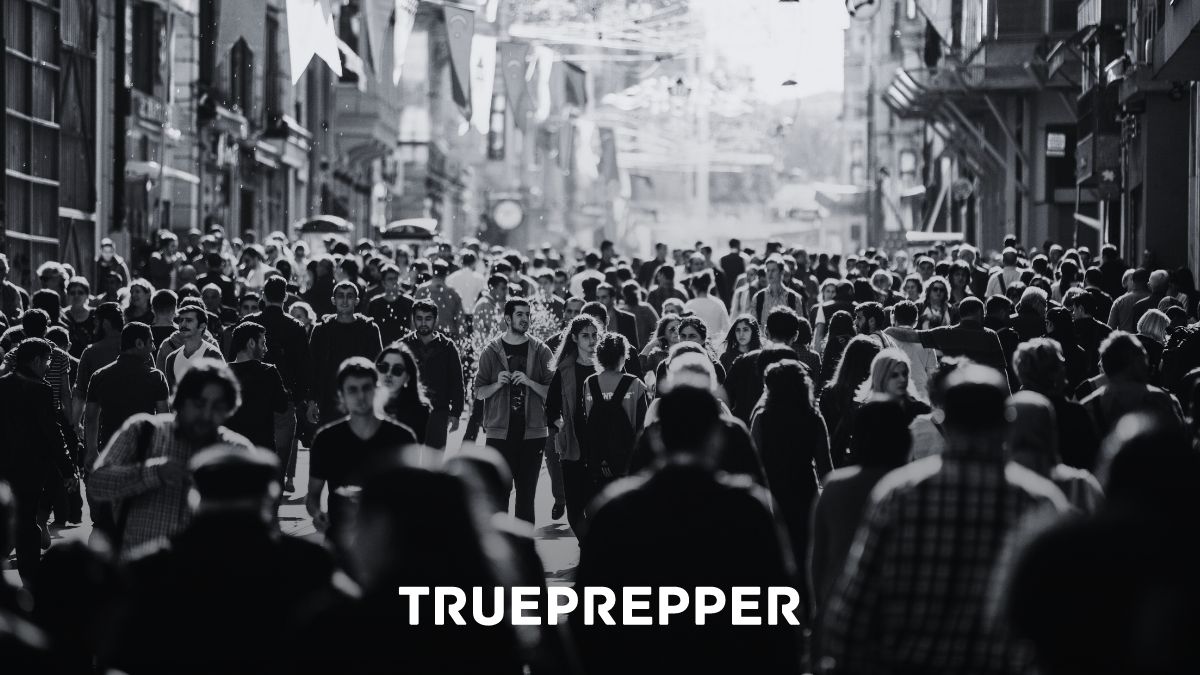
What to Pack in a Survival Backpack?
Survival bags accommodate a huge range of survival kits. The kit type determines what you pack in the, although many kits share the same types of resources.
Survival backpacks are designed to be filled with survival gear, so of course, we have plenty of mobile survival kits that require them:
- Bug Out Bag List – Evacuation-style survival kit (aka go-bag or 72-hour kit).
- Get Home Bag List – Survival kit designed to help you get home.
- Everyday Carry List – Bag you plan to keep with you every day.
- INCH Bag List – Similar to a bug out bag, but for indefinite survival.
- SCARE Kit List – Survival kit designed for urban unrest.
Having a backpack on hand, and getting the right gear inside of it can go a long way for preparedness.
How We Review Products: We research thoroughly before selecting the best products to review. We have vast prepping and survival experience and bring in outside experts when needed. Hours on end are spent testing gear in stressful conditions and using specialized testing gear to verify claims. We assign performance criteria and impartially rate each tested item. Learn more about how we test.
Sources and References
All of our experience and the testing we do to determine the best survival backpack is useless without listing our research sources and references. We leaned on these for the book knowledge that we paired with our hands-on testing and practical military and prepping experience:
Harman, E., et al. (2000). The Effects of backpack weight on the biomechanics of load carriage. ARMY RESEARCH INST OF ENVIRONMENTAL MEDICINE. (Source)
Devroey, C., et al. (2007). Evaluation of the effect of backpack load and position during standing and walking using biomechanical, physiological and subjective measures. Ergonomics. Volume 50. Issue 5. Pages 728 – 742. (Source)
Labosier, C. (2019). Bug out bags and first aid kits: Undergraduate college students’ awareness, perceptions, preparedness, and behavior around severe weather. Emerging Voices in Natural Hazards Research. Pages 1 – 25. (Source)
The Final Word
These survival bags will all do the job but come with varying price tags, comfort levels, capacity, and durability. The tactical bags win the durability contest with the backpacking bags coming in a close second.
Backpacking bags can be tuned to fit like a glove, and are available in very high capacities. The backpacks you already own in your closet are cheap and can still get the job done in most circumstances.
Our subscribers have also found these guides helpful:
- The Survival Rule of 3 | Air, Shelter, Water, & Food
- The Best Gray Man Backpack for Survival and Prepping
- Bug Out Bag List | 44 Essentials
After our exhaustive testing, we recommend the 5.11 Rush 72 2.0 Backpack for most applications (sometimes in other sizes) and the Teton Scout 55 Backpack for everyone on a budget.
Keep exploring, stay prepared, and be safe.
You’ve Been Missing Out
Join the 2+ million preppers that rely on our prepping advice by subscribing to TruePrepper.- Practical guides and tips
- Useful survival giveaways
- Free, forever
- < 0.4% of people unsubscribe
